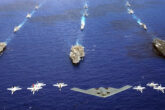February 05, 2018
How the United States Can Get More Strategic Bang For Its Force Structure Buck
Secretary of Defense Jim Mattis released an unclassified summary of the new National Defense Strategy two weeks ago. The big news in the strategy is a front-and-center focus on strategic competition with China and Russia. Though this change is evolutionary, not revolutionary, it provides badly needed clarity amidst the chaos that has been a hallmark of the Trump administration to date. Particularly notable is the strategy’s unambiguous direction to “build a more lethal joint force” in part by “prioritizing preparedness for war.”
A return to strategic competition against China and Russia, who both have the technology and the resources to challenge the U.S. military’s ability to operate freely in their respective regions, requires the Pentagon to think differently about the way it uses the military — or what’s known as force employment. To compete effectively against China and Russia while maintaining commitments in the Middle East, the Defense Department will need to figure out how to maximize the strategic impact of the size and capability of the force it has now — dubbed “force structure” in Pentagonese — by developing a new force employment model. In other words, it needs to figure out how to get more strategic “bang” out of its force structure “buck.”
Civilian and military leaders have been talking about the need for a more dynamic global presence for some years now, recognizing the fact that America’s post-Cold War force employment is generally static. The military tends to repeat the same deployments and exercises in the same places in the same ways year after year, without much consideration of how these events affect high-end competitors’ decision-making. This pattern of force employment cannot continue if the military is to execute the National Defense Strategy. The primacy of competition against China and Russia in the strategy requires that the United States change its approach to force employment in at least three ways.
Read the full article in War on the Rocks.
More from CNAS
-
Defense / Indo-Pacific Security
Is the U.S. Ready for War with China?U.S. military planners are caught in an impossible dilemma....
By Franz-Stefan Gady
-
The Pentagon Is Using Artificial Intelligence Right Now. Here’s How.
Artificial intelligence is the future of the military, or so Pentagon leaders keep saying. But is it the future — or is that future already here? That’s the question Breaking ...
By Josh Wallin
-
Stuck in the Cul-de-Sac
For more than a decade, the United States has sought to modernize its military to deter China, but it has become stuck in a developmental cul-de-sac that has allowed China to ...
By Carlton Haelig & Philip Sheers
-
Defense / Transatlantic Security
MWI Podcast: Europe’s Airspace Violations and the Counterdrone ChallengeJohn Amble is joined on this episode of the MWI Podcast by Dr. Stacie Pettyjohn, a senior fellow and director of the Defense Program at the Center for a New American Security....
By Stacie Pettyjohn




